A relic of toy trends from the 2000s, these cheap assembled models make for a decent little novelty item, as long as you’re delicate with them.
I’ve never been much of a “card” collector, so I’ve never followed the hobby closely, but I do recall a time in the early 2000s when 3D card models like Z-Cardz and Star Wars Pocketmodels became all the rage, at least within my own friend circles. Z-Cardz in particular caught my attention as a kid because, naturally, they had a series of dinosaur models. Not a lot of information regarding the brand seems to exist online anymore, as the line seems to have gone defunct some time before the 2010s. First conceived in 2000 by California Creations, Z-Cardz were licensed by a company titled The Original San Francisco Toymakers and began hitting US store shelves in early 2001. Z-Cardz quickly exploded in popularity, and over the next few years, they would produce hundreds of punch-out 3D models, which ranged from wildlife to race and military vehicles to licensed properties like superheroes and to the aforementioned dinosaurs. These models could be purchased individually or in sets (in series or blind packs), and kids could then set up battle games by amassing their own “army” of minifigures (with accompanying stat cards) to pit against one another. Personally, I was satisfied to just obtain all the dinosaurs. In time, however, these fragile little models were stashed away and forgotten about amidst the rest of my collection, until I unearthed them again a couple of years ago. A total of twenty “dinosaurs” were produced for Z-Cardz, released individually and in sets. Each card came with punch-out pieces which required simple assembly. For the dinosaurs, these typically consisted of a large head/body piece, limbs, and in-between “shoulder/hip” joints. Information on the Z-Cards line can be tricky to find since the line ended, but it appears there were two sets each of “Dinosaur” and “Prehistoric” sets released. So for this review, we’ll be looking at the first five figures, released as “Dinosaurs” Series 1. Depending on the models, Z-Cardz could produce some fairly intricate designs, so how do these dinos hold up?
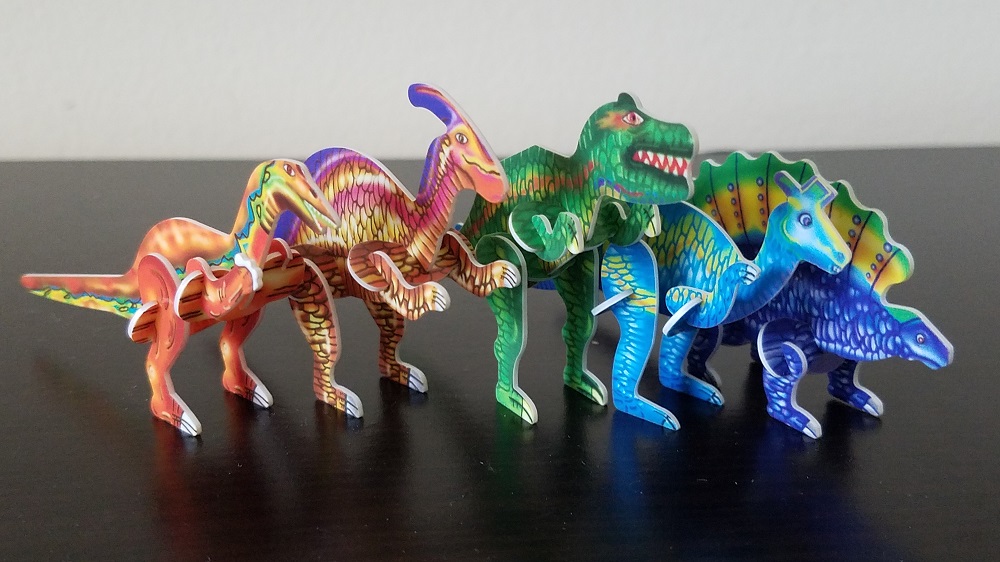
The first dinosaur in the set, card # 201, is labelled as Spinosaurus–and right away we can see this series is off to an “interesting” start. Rather than the bipedal, crocodile-snouted predator that was just becoming famous at the time, this “Spino” has a small, blunt head, an oblong body, four limbs that look built for quadrupedalism, and a curved, scalloped sail. All in all, it’s actually way more accurate to the pelycosaur Edaphosaurus, so I suspect someone simply did poor research when designing the model. It wasn’t uncommon for 20th century depictions of Spinosaurus to feature four legs and and rounded skull, to the point that I suspect many artists had the dinosaur confused with Dimetrodon, another famous pelycosaur which predated the dinosaurs (and is actually believed to be more closely related with mammals). The Z-Card Spino might be the first time I’ve seen the herbivorous Edaphosaurus be the victim of mistaken identity instead. The model is a decent representation of the animal, although there are a couple of quirks: the curvature of the sail is exaggerated, and the legs assemble so that the forelimbs are suspended off the ground, despite the feet being shaped to rest on the ground. The model is a little unbalanced, but a switch of the front and back limb pieces will have the figure stable on all fours. Large, irregular scales are patterned across the body, with clawed feet and a ribbed sail. The body is colored in gradients of deep sea blue, with bright yellow and green highlights on the sail. It’s an appealing little model, as long as one views it as an Edaphosaurus instead of a Spinosaurus.

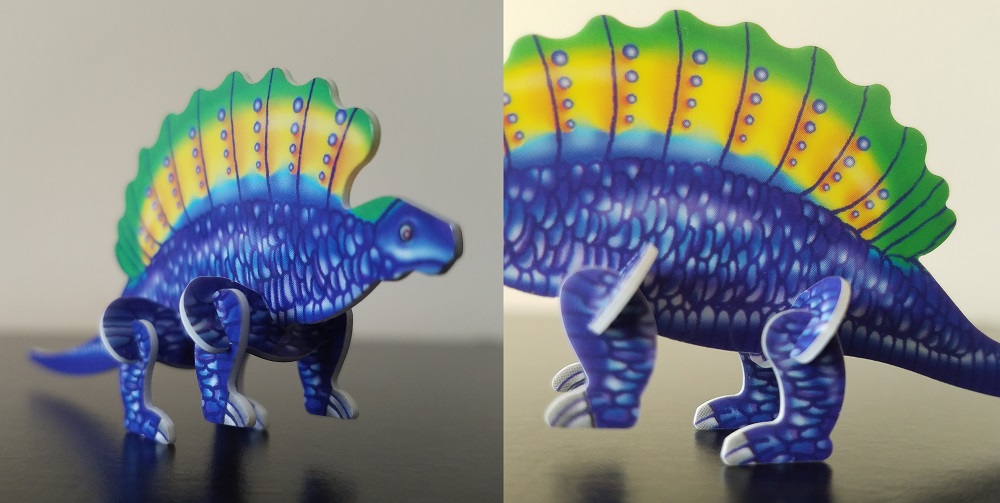
Card # 202 in the set is Lambeosaurus, a somewhat rarer genus among toys. The assembled model is posed with its forearms up and eyes wide, as if the animal was just scared by something. The effect is rather comical, but it makes for a slightly more dynamic figure. The animal appears to be depicted as primarily bipedal, with large back feet and short forelimbs; hadrosaurids have commonly been depicted as bipeds, but in more recent years, evidence has supported a more quadrupedal stance. The distinctive checkmark crest is present, but the overall body shape is round and nondescript. The same heavy, overlapping scales and large toes are present in the painted patterns, with a smoother face and what looks like the outline of the jaw. We do actually have skin impressions of some hadrosaurids, but the fine scalation preserved in fossils couldn’t possibly be translated to a model of this size. For a simple toy like this, large scales read more easily for kids. The model is decked out in stripes of bright turquoise and yellow-green, along with a hint of purple on the crest and the belly. Such a color scheme might be more appropriate on a tropical fish than a large terrestrial herbivore, but it’s pretty and eye-catching and that’s probably all it’s meant to be.
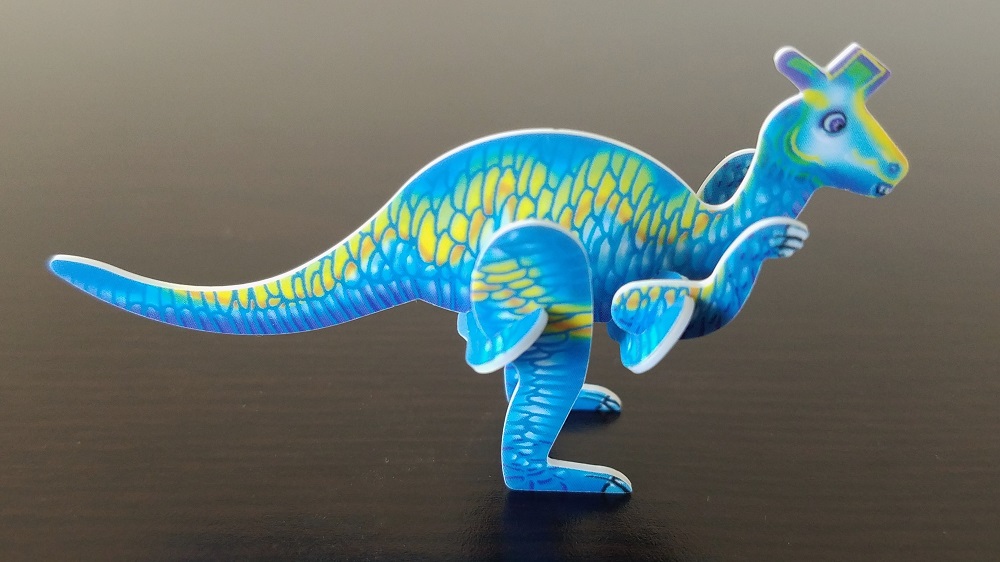
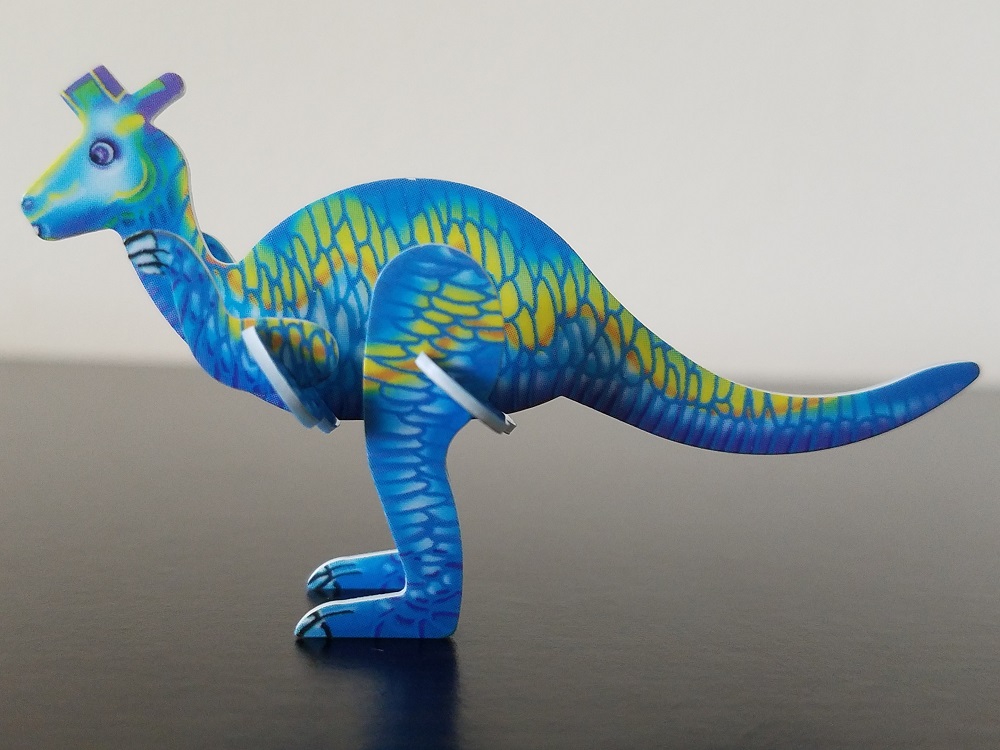
Card # 203 is the familiar theropod Allosaurus, one of the larger figurines in this set. The Allosaurus is a mean-looking character, with its teeth bared and eyes bloodshot. The skull is impressively large, probably exaggerated for effect, with a bump that’s probably supposed to be the genus’ recognizable lacrimal crest placed right above the eyes. The arms are curled in the stereotypical praying mantis pose, with the body raised semi-upright, but the tail is kept raised off the ground (if it can stay balanced). The body features large painted scales and claws, with an overall color scheme of jungle green with yellow highlights. a reddish-orange stripe runs down the body, and some aggressive fiery highlights are applied behind the eyes. To be perfectly honest, apart from the color scheme, this is a rather ugly model: its head is misshapen, the body is lumpy, and the hind legs are set awkwardly low on the body. There’s not much here to identify the animal as Allosaurus, however, the model does its job at looking like a big, mean killer dinosaur, and since I can attest to it being one of my favorites as a kid out of this line, I’d say it works pretty well.
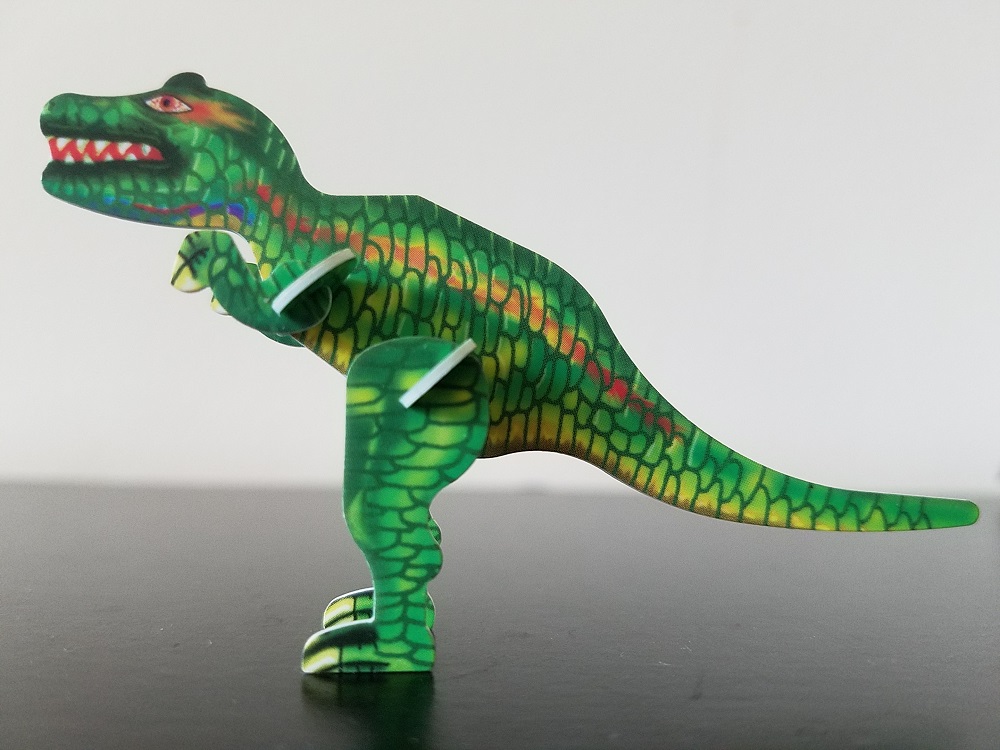
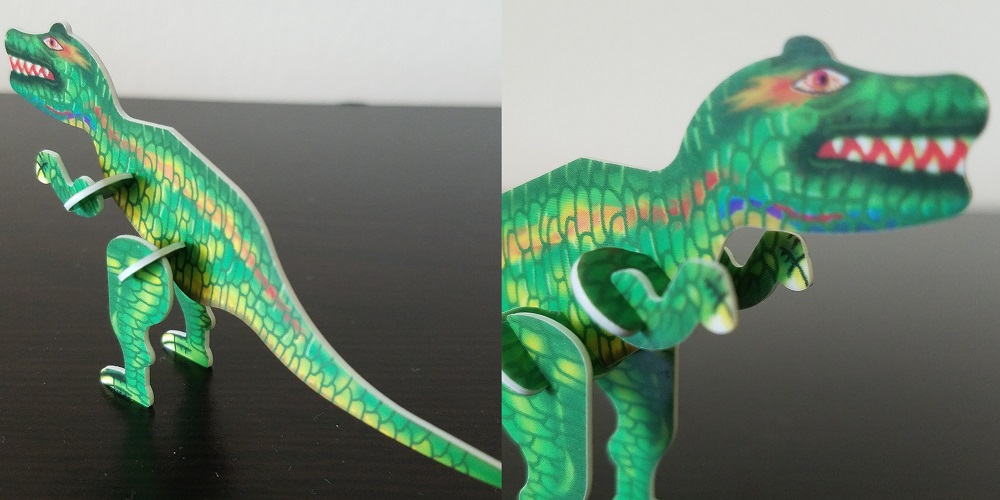
Card # 204 is Parasaurolophus, posed in a basic bipedal stance somewhere in between that of the Lambeosaurus and the Allosaurus. Like the Lambeosaurus, the Para doesn’t look too capable of a four-legged stance here, even though scientific standing has leaned more that way for a while. That said, the hind legs still look rather stumpy and awkwardly low-set on the body. The body itself is remarkably round, suggesting a fairly large animal; hadrosaurs could indeed be quite massive. The tail slopes precariously low to the ground, but still manages to stay balanced in the air. The prominent head crest, of course, is present on the model, with an S-curve in the neck–this is a recognizable silhouette for any young dinosaur fan, but a bit old-fashioned in looks. The colors are fairly nice, with gradient stripes of brown and gold topped with a deep purple, and tints of pink and rosy red on the neck and mouth. Regrettably, the dark mouth line itself appears to have been mispainted on my own model, making it look big-lipped and mustached rather than beaked or whatever else. The same scaling pattern is applied here, staying consistent with the other models so far.

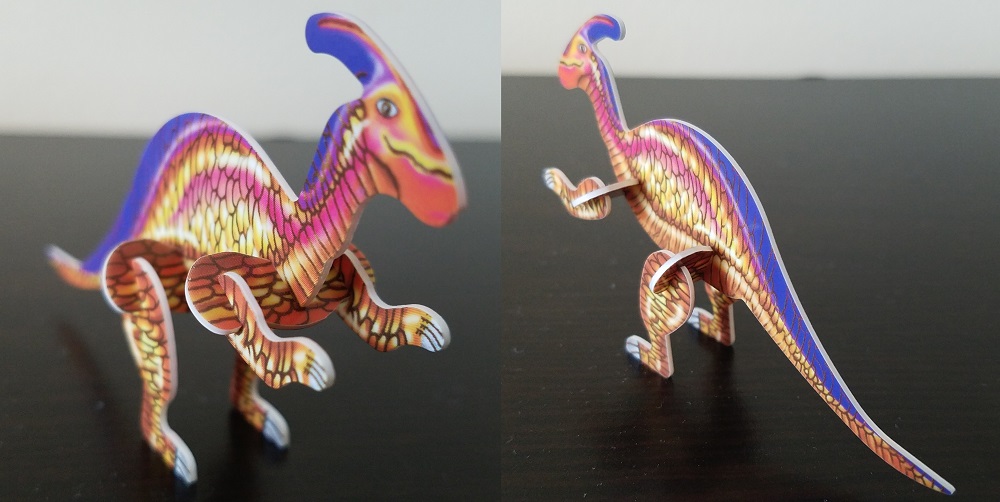
Card # 205 is Coelophysis, one of few Triassic dinosaurs to get much attention in pop culture. As I briefly mentioned before, Z-Cardz are fragile by nature; they’re not meant for rough play, and even a small mistake can spell trouble. My Coelophysis is sadly a testament to this, as you can see from the missing arm in the photos. Although a gracile animal in nature, the Z-Cardz version of this animal is looking rather pudgy, albeit still with a pointy skull and long neck and tail. Unlike the previous four models in the set, Coelophysis has individual fingers, four in total per hand, giving the model slightly more intention in its posture with arms reaching out. The legs are positioned weirdly forward on the body, with its back half low to the ground. There’s a curious little bump atop the model’s head, which I’m going to assume is a lacrimal crest. It’s an oddly-shaped model overall, when examined closely; Z-Cardz doesn’t seem to bat very well for theropods in this set. Consistently, though, Coelophysis does come painted in eye-catching colors, with bright intersecting stripes of blue, yellow, and green running from head to tail over a rich fiery orange body. Surprisingly, no large scale patterns are painted on this figure.
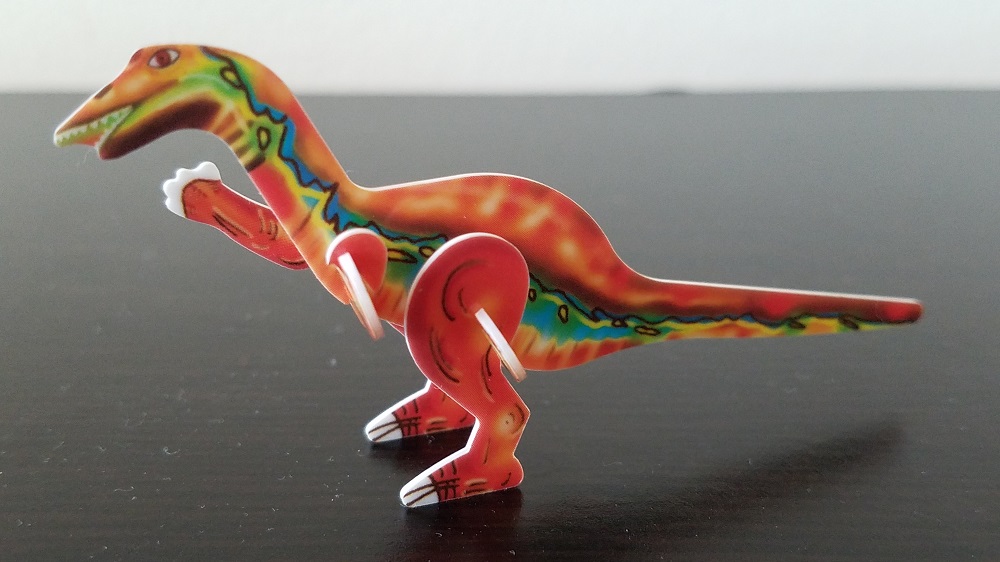

The Z-Cardz Dinosaurs Series 1 obviously isn’t going to win any prizes for standout or cutting-edge reconstructions, but as colorful and fairly recognizable kids’ collectibles, they’re pretty cute for a few dollars. The models are probably going to cost a bit more than that on the second-hand market these days, of course. Consider them a minor novelty that could still be fun for your collection, or for something different for your kids to mess with (gently).
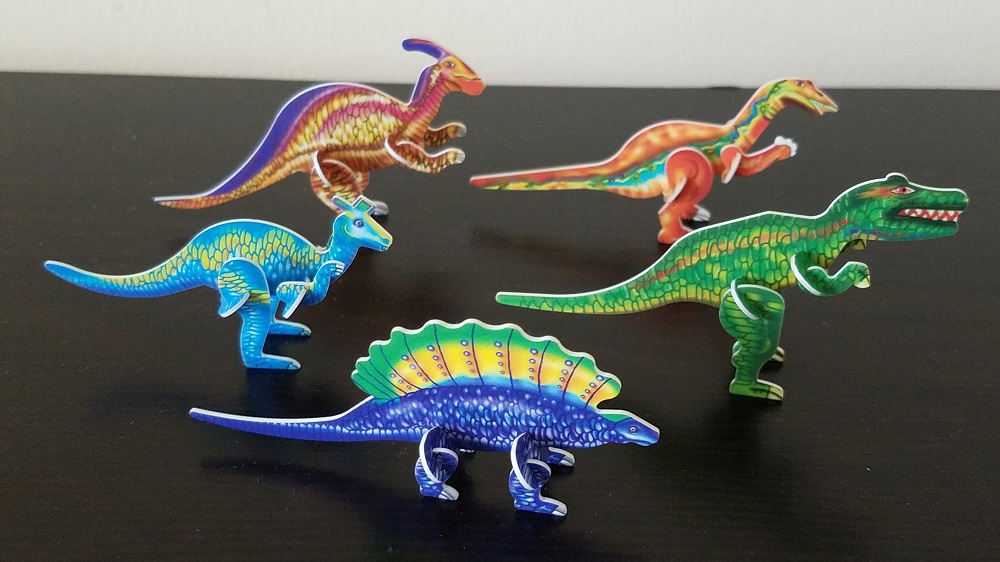
Support the Dinosaur Toy Blog by making dino-purchases through these links to Ebay and Amazon. Disclaimer: links to Ebay.com and Amazon.com on the The Dinosaur Toy Blog are often affiliate links, when you make purchases through these links we may make a commission
